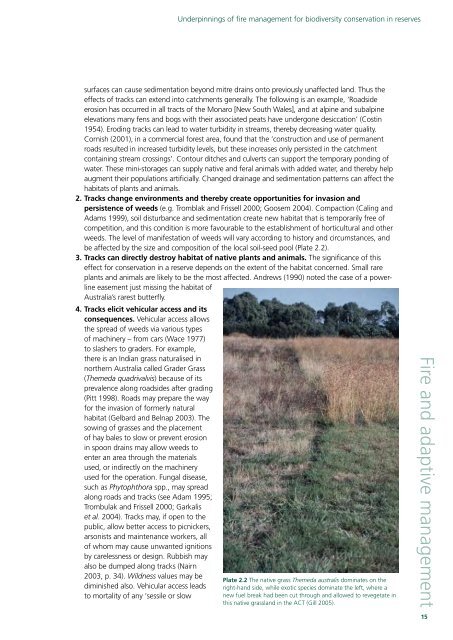Underpinnings of fire management for biodiversity conservation in ...
Underpinnings of fire management for biodiversity conservation in ...
Underpinnings of fire management for biodiversity conservation in ...
Create successful ePaper yourself
Turn your PDF publications into a flip-book with our unique Google optimized e-Paper software.
<strong>Underp<strong>in</strong>n<strong>in</strong>gs</strong> <strong>of</strong> <strong>fire</strong> <strong>management</strong> <strong>for</strong> <strong>biodiversity</strong> <strong>conservation</strong> <strong>in</strong> reserves<br />
surfaces can cause sedimentation beyond mitre dra<strong>in</strong>s onto previously unaffected land. Thus the<br />
effects <strong>of</strong> tracks can extend <strong>in</strong>to catchments generally. The follow<strong>in</strong>g is an example, ‘Roadside<br />
erosion has occurred <strong>in</strong> all tracts <strong>of</strong> the Monaro [New South Wales], and at alp<strong>in</strong>e and subalp<strong>in</strong>e<br />
elevations many fens and bogs with their associated peats have undergone desiccation’ (Cost<strong>in</strong><br />
1954). Erod<strong>in</strong>g tracks can lead to water turbidity <strong>in</strong> streams, thereby decreas<strong>in</strong>g water quality.<br />
Cornish (2001), <strong>in</strong> a commercial <strong>for</strong>est area, found that the ‘construction and use <strong>of</strong> permanent<br />
roads resulted <strong>in</strong> <strong>in</strong>creased turbidity levels, but these <strong>in</strong>creases only persisted <strong>in</strong> the catchment<br />
conta<strong>in</strong><strong>in</strong>g stream cross<strong>in</strong>gs’. Contour ditches and culverts can support the temporary pond<strong>in</strong>g <strong>of</strong><br />
water. These m<strong>in</strong>i-storages can supply native and feral animals with added water, and thereby help<br />
augment their populations artificially. Changed dra<strong>in</strong>age and sedimentation patterns can affect the<br />
habitats <strong>of</strong> plants and animals.<br />
2. Tracks change environments and thereby create opportunities <strong>for</strong> <strong>in</strong>vasion and<br />
persistence <strong>of</strong> weeds (e.g. Tromblak and Frissell 2000; Goosem 2004). Compaction (Cal<strong>in</strong>g and<br />
Adams 1999), soil disturbance and sedimentation create new habitat that is temporarily free <strong>of</strong><br />
competition, and this condition is more favourable to the establishment <strong>of</strong> horticultural and other<br />
weeds. The level <strong>of</strong> manifestation <strong>of</strong> weeds will vary accord<strong>in</strong>g to history and circumstances, and<br />
be affected by the size and composition <strong>of</strong> the local soil-seed pool (Plate 2.2).<br />
3. Tracks can directly destroy habitat <strong>of</strong> native plants and animals. The significance <strong>of</strong> this<br />
effect <strong>for</strong> <strong>conservation</strong> <strong>in</strong> a reserve depends on the extent <strong>of</strong> the habitat concerned. Small rare<br />
plants and animals are likely to be the most affected. Andrews (1990) noted the case <strong>of</strong> a powerl<strong>in</strong>e<br />
easement just miss<strong>in</strong>g the habitat <strong>of</strong><br />
Australia’s rarest butterfly.<br />
4. Tracks elicit vehicular access and its<br />
consequences. Vehicular access allows<br />
the spread <strong>of</strong> weeds via various types<br />
<strong>of</strong> mach<strong>in</strong>ery – from cars (Wace 1977)<br />
to slashers to graders. For example,<br />
there is an Indian grass naturalised <strong>in</strong><br />
northern Australia called Grader Grass<br />
(Themeda quadrivalvis) because <strong>of</strong> its<br />
prevalence along roadsides after grad<strong>in</strong>g<br />
(Pitt 1998). Roads may prepare the way<br />
<strong>for</strong> the <strong>in</strong>vasion <strong>of</strong> <strong>for</strong>merly natural<br />
habitat (Gelbard and Belnap 2003). The<br />
sow<strong>in</strong>g <strong>of</strong> grasses and the placement<br />
<strong>of</strong> hay bales to slow or prevent erosion<br />
<strong>in</strong> spoon dra<strong>in</strong>s may allow weeds to<br />
enter an area through the materials<br />
used, or <strong>in</strong>directly on the mach<strong>in</strong>ery<br />
used <strong>for</strong> the operation. Fungal disease,<br />
such as Phytophthora spp., may spread<br />
along roads and tracks (see Adam 1995;<br />
Trombulak and Frissell 2000; Garkalis<br />
et al. 2004). Tracks may, if open to the<br />
public, allow better access to picnickers,<br />
arsonists and ma<strong>in</strong>tenance workers, all<br />
<strong>of</strong> whom may cause unwanted ignitions<br />
by carelessness or design. Rubbish may<br />
also be dumped along tracks (Nairn<br />
2003, p. 34). Wildness values may be<br />
dim<strong>in</strong>ished also. Vehicular access leads<br />
to mortality <strong>of</strong> any ‘sessile or slow<br />
Plate 2.2 The native grass Themeda australis dom<strong>in</strong>ates on the<br />
right-hand side, while exotic species dom<strong>in</strong>ate the left, where a<br />
new fuel break had been cut through and allowed to revegetate <strong>in</strong><br />
this native grassland <strong>in</strong> the ACT (Gill 2005).<br />
Fire and adaptive <strong>management</strong> 15





![Metcalfe State Forest Fauna Species List [PDF File - 16.9 KB]](https://img.yumpu.com/22024301/1/184x260/metcalfe-state-forest-fauna-species-list-pdf-file-169-kb.jpg?quality=85)






![PPE Price List for Wildlife Volunteers [PDF File - 20.3 KB]](https://img.yumpu.com/15321634/1/190x135/ppe-price-list-for-wildlife-volunteers-pdf-file-203-kb.jpg?quality=85)




